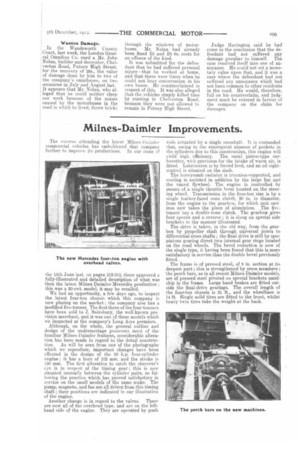Milnes-Daimler Improvements.
Page 13

If you've noticed an error in this article please click here to report it so we can fix it.
The success attending the latest Mihies-Daiader commercial vehicles has emboldened that company further to improve its productions. In our issue of
the 13th June last, on pages 312-313, there appeared a fully-illustrated and detailed description of what was then the latest Milnes-Daimler-Mereedes production ; this was a 20-cwt. model, it may be recalled. We had an opportunity, a few days ago, to inspect the latest four-ton chassis which this company is now placing on the market ; the company also has a modified five-tonner. The first three of the four-tonners have been sold to J. Sainsbury, the well-known provision merchant, and it was one of these models which we inspected at the company's Long Acre premises. Although, on the whole, the general outline and design of the undercarriage possesses most of the familiar Milnes-Daimler features, considerable alteration has been made in regard to the detail construction. As will be, seen from one of the photographs which we reproduce, important changes have been effected in the design of the 30 h.p. four-cylinder engine ; it has a bore of 102 mm. and the stroke is 150 mm, The first alteration to catch the observer's eye is in respect of the timing gear ; this is now situated centrally between the cylinder pairs, so following the practice which has proved satisfactory in service on the small models of the same make.. The pump, magneto, and fan are all driven from this timing shaft ; their positions are indicated in our illustration of the engine.
Another change is in regard to the valves. These are now all of the overhead type, and are on the lefthand side of the engine. They are operated by push rods actuated by a single camshaft. it is contended that, owing to the consequent absence of pockets in the cylinders due to this construction, this engine will yield high efficiency. The usual piston-type carburetter, with provision for the intake of warm air, is fitted. Lubrication is by forced feed, and an oil sightcontrol is situated on the dash.
The honeycomb radiator is trunnion-supported, and cooling is assisted in addition by the large fan and the vaned flywheel. The engine is controlled by means of a single throttle lever located on the steering wheel. Transmission in the four-ton size is by a single leather-faced cone clutch, 20 in. in diameter, from. the engine to the gearbox, for which unit castiron now takes the place of aluminium. The fivttonner has a double-cone clutch. The gearbox gives four speeds and a reverse ; it is slung on special side brackets in the manner illustrated.
The drive is taken, in the old way, from the gearbox by propeller shaft through universal joints to differential cross shafts ; thermal drive is still by spur pinions gearing direct into internal gear rings located on the road wheels. The bevel reduction is now of the single type, it having been found that this is more satisfactory in service than the double bevel previously fitted.
The frame is of pressed steel, of 8 in. section at its deepest part ; this is strengthened by cross members ; the perch bars, as in all recent Milnes-Daimler models, are of pressed steel pivoted on special brackets amidship in the frame. Large band brakes are fitted outside the final-drive gearing& The overall length of the four-ton chassis is 21 ft., and the wheelbase is 14 ft. Single solid tires are fitted to the front., whilst heavy twin tires take the weight at the back.


























